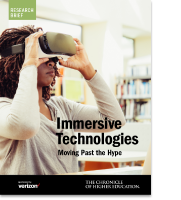

.

Much has been said about the rise of immersive technologies — and their potential in and out of the classroom. But, how do higher education institutions really regard this technology, and what do leaders view as merely hype?
To find out, The Chronicle surveyed 285 higher ed administrators at two- or four-year institutions. The findings are detailed in the new Research Brief, “Immersive Technologies: Moving Past the Hype.” Download the report to read the results and our detailed analysis of the findings, including:
- Reasons for adopting the technology: 47 percent of those surveyed listed pedagogical innovation as the main driver, with 5 percent citing educational value obtained from data.
- Student interest in VR and AR: 27 percent of those surveyed said their students were very interested in immersive technologies, with only 1 percent stating students were not interested at all.
- Key benefits of immersive technologies: 89 percent cited allowing students to test real-world lessons in low-risk situations.
- Barriers to widespread use: 62 percent claimed the technologies were cost prohibitive
By submitting this form, I agree to share my information with The Chronicle and Verizon for marketing purposes.
.
Much has been said about the rise of immersive technologies — and their potential in and out of the classroom. But, how do higher education institutions really regard this technology, and what do leaders view as merely hype?
To find out, The Chronicle surveyed 285 higher ed administrators at two- or four-year institutions. The findings are detailed in the new Research Brief, “Immersive Technologies: Moving Past the Hype.” Download the report to read the results and our detailed analysis of the findings, including:
- Reasons for adopting the technology:
47 percent of those surveyed listed pedagogical innovation as the main driver, with 5 percent citing educational value obtained from data. - Student interest in VR and AR:
27 percent of those surveyed said their students were very interested in immersive technologies, with only 1 percent stating students were not interested at all. - Key benefits of immersive technologies:
89 percent cited allowing students to test real-world lessons in low-risk situations. - Barriers to widespread use:
62 percent claimed the technologies were cost prohibitive
.
.

